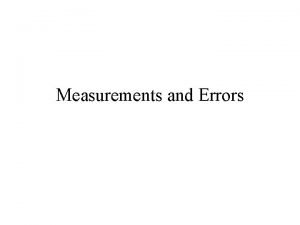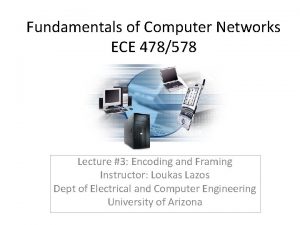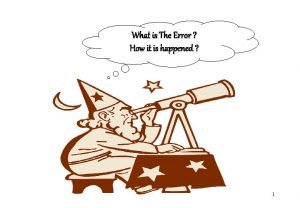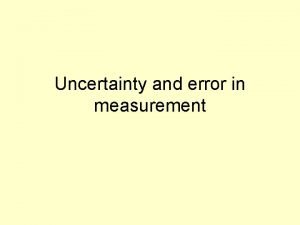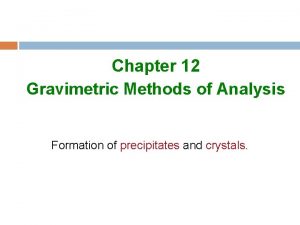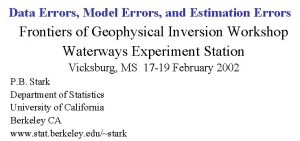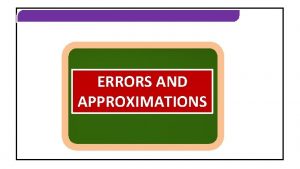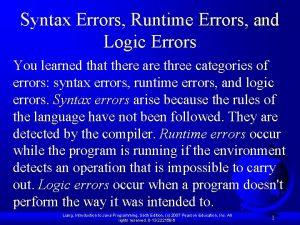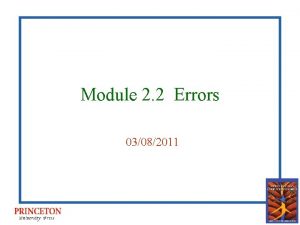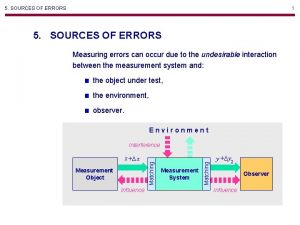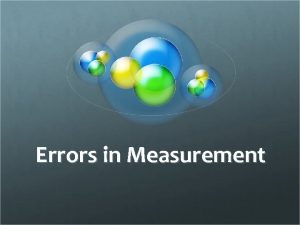5 SOURCES OF ERRORS 1 5 SOURCES OF














- Slides: 14

5. SOURCES OF ERRORS 1 5. SOURCES OF ERRORS Measuring errors can occur due to the undesirable interaction between the measurement system and: the object under test, the environment, observer. Environment Measurement Object Influence Measurement System Matching x+D x Matching Interference y +Dy 12 Observer Influence

5. SOURCES OF ERRORS. 5. 1. Influencing the measurement object: matching. 5. 1. 1. Anenergetic matching 2 5. 1. Influencing the measurement object: matching 5. 1. 1. Anenergetic matching is used to minimize the transfer of energy between the measurement object and the measurements system. After matching, measurement will not supply any appreciable energy to, or receive from the measurement object. Anenergetic matching is usually used in active measurement systems, which do possess internal power amplification. Reference: [1]

5. SOURCES OF ERRORS. 5. 1. Influencing the measurement object: matching. 5. 1. 1. Anenergetic matching Example: Anenergetic matching Measurement object Rmsr >> Rs Vmsr Vin; Vin the power supplied by the object is small; most part of it is dissipated in Vmsr Rmsr. Measurement object Rmsr << Rs Imsr Iin; Iin the power supplied by the object is small; most part of it is dissipated in Measurement system Rmsr. Measurement system Imsr Rin 3

5. SOURCES OF ERRORS. 5. 1. Influencing the measurement object: matching. 5. 1. 2. Energic matching 4 5. 1. 2. Energic matching The aim of energic matching is to extract the maximum available power from the measurement object, so that the required power gain in the measurements system can be as small as possible. Anenergetic matching is especially important for passive measurement systems, which do not possess internal power amplification. Reference: [1]

5. SOURCES OF ERRORS. 5. 1. Influencing the measurement object: matching. 5. 1. 2. Energic matching 5 To optimize the energic matching, let us consider the following equivalent circuits of the measurement object and the measurement system. Measurement object Measurement system Zs = R s + X s Vin Zmsr= Rmsr + Xmsr Vmsr The average power delivered to the measurement system can be found as: Pavg = I 2 Rin = Vs 2 Rmsr (Rs+ Rmsr)2+ (Xs+Xmsr)2 .

5. SOURCES OF ERRORS. 5. 1. Influencing the measurement object: matching. 5. 1. 2. Energic matching 6 For a given Ro, this power is maximal if the following optimal matching is obtained: Rmsr= Rs and Xmsr = - Xs or Zmsr= Zs*. Therefore, the maximum power a measurement object can deliver to a measurement system is: V s 2 Pavg = = 4 Rmsr V s 2. 4 Rs Reference: [1]

5. SOURCES OF ERRORS. 5. 1. Influencing the measurement object: matching. 5. 1. 2. Energic matching 7 If Ro can be adjusted, then the optimal matching is obtained when Ro = 0 and Xmsr = - Xo. The maximum power a measurement object can deliver to a measurement system is in this case: V s 2 Pavg =. 2 Rmsr Reference: [1]

5. SOURCES OF ERRORS. 5. 1. Influencing the measurement object: matching. 5. 1. 2. Energic matching 8 Available power is defined as the maximum power that can be delivered to a load from a source having fixed nonzero resistance Pa Pavg = R o 0 Vin 2. 4 Ro NB: The maximum power matching usually causes greater measurement errors, since the input and output impedances of the chain affect the measurement. For this reason, the measurement systems almost always used are active systems (with built-in power gain). Reference: [1]

5. SOURCES OF ERRORS. 5. 1. Influencing the measurement object: matching. 5. 1. 3. Non-reflective matching 9 5. 1. 3. Non-reflective matching Non-reflective or characteristic matching is used for transporting high-frequency measurement signals along transmission lines. If a transmission line is not terminated characteristically, reflections off the ends of the line will cause standing waves on the line; the line output signal is no longer a good measure for the line input signal. The characteristic impedance, Z 0, of a transmission line equals its input impedance if if the transmission line length were infinite. For a lossless transmission line with the series inductance per meter L and the parallel capacitance per meter C, Z 0 = L = R 0. C Reference: [1]

5. SOURCES OF ERRORS. 5. 1. Influencing the measurement object: matching. 5. 1. 3. Non-reflective matching 10 Illustration: Non-reflective matching: Ro= R 0= Rin Measurement object Rs Measurement system Z 0 Vin Rmsr Vmsr = 0. 5 Vin NB: When Ro= R 0= Rmsr holds, energic matching is also achieved simultaneously, since Ro= Rmsr. R 0 is an apparent resistance that does not dissipate energy; half of the energy delivered by Vin is dissipated in Ro and the other half in Rmsr. Reference: [1]

5. SOURCES OF ERRORS. 5. 1. Influencing the measurement object: matching. 5. 1. 3. Non-reflective matching 11 Example: The characteristic impedances of different connections Type of connection DEFINITION Characteristic impedance Coaxial cable 50 - 75 W Printed circuit board traces 50 - 150 W Twisted wire pairs 100 - 120 W Ribbon cable 200 - 300 W Free space 376 W Reference: [1]

5. SOURCES OF ERRORS. 5. 1. Influencing the measurement object: matching. 5. 1. 4. When to match and when not? 12 5. 1. 5. When to match and when not? Do match by adjusting impedances, by adding voltage buffers or by adding matching transformers: To transfer maximum power to the load. The source must be capable. To minimise reflections from the load. Important in audio, fast (high frequency) systems, to avoid ringing or multiple pulses (e. g. in counting systems). To transmit fast pulses. Pulse properties can contain important information. Note that the same physics is encountered in other areas, e. g. optical coatings, gel in ultrasound scans, optical grease, etc. Reference: www. hep. ph. ic. ac. uk/Instrumentation/

5. SOURCES OF ERRORS. 5. 1. Influencing the measurement object: matching. 5. 1. 4. When to match and when not? 13 Do not match: High impedance source with small current signals. Typical for many photodiode sensors, or other sensors that must drive high impedance load. Short cables are required to avoid difficulties. Weak voltage source. Drawing power from source would affect the result, e. g. bridge circuits. If you need to change properties of a fast pulse, e. g. pulse widening for ease of detection. Electronics with limited drive capabilities, e. g. logic circuits, many are designed to drive other logic, not long lines, CMOS circuits, even with follower, are an example. Reference: www. hep. ph. ic. ac. uk/Instrumentation/

Next lecture 14 Next lecture:
 Print sources and web sources
Print sources and web sources Importance of water resources
Importance of water resources Flow and error control
Flow and error control Instrumental error definition
Instrumental error definition How to play river shen
How to play river shen Errors not affecting trial balance with examples
Errors not affecting trial balance with examples Correct the errors
Correct the errors Relative true error formula
Relative true error formula Levelt's model of speech production
Levelt's model of speech production Common errors in investment management
Common errors in investment management Alice yawned as her eyes cracked open figurative language
Alice yawned as her eyes cracked open figurative language Errors and suspense
Errors and suspense Random errors may be detected by repeating the measurements
Random errors may be detected by repeating the measurements 10 common communication mistakes
10 common communication mistakes Mechanical entrapment coprecipitation
Mechanical entrapment coprecipitation



